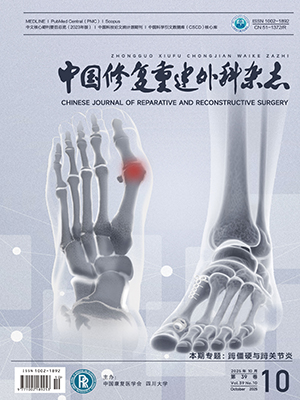Objective To evaluate the effectiveness of correcting post-traumatic equinovarus deformity using Ilizarov external fixation technique combined with limited osteotomy. Methods A retrospective analysis was conducted on clinical data from 29 patients with post-traumatic equinovarus deformity treated between July 2018 and March 2023. The cohort included 18 males and 11 females, with ages ranging from 15 to 57 years (mean, 24.3 years). All patients exhibited ankylosed ankle joints with equinovarus deformity. During surgery, external fixators were installed according to Ilizarov pinning principles, and minimally invasive osteotomy was performed at the ankle joint. Concurrently, soft tissue release was achieved via minimally invasive Achilles tendon lengthening. Postoperatively, multiplanar deformity correction was accomplished through gradual adjustment of the external fixator. The fixator was removed after bony union at the osteotomy site, followed by bracing. The surgical duration, intraoperative blood loss, fixator wear time, and complications were recorded. Postoperative outcomes included assessment of deformity correction and bony union at the osteotomy site. Functional improvement and pain relief were evaluated using pre- and post-operative scores from the American Orthopaedic Foot & Ankle Society (AOFAS) ankle-hindfoot score and visual analogue scale (VAS) score. Results All 29 patients were followed up 12-24 months (mean, 18 months). The mean surgical duration was 85.6 minutes, with a mean intraoperative blood loss of 110 mL. Full deformity correction was achieved within 26-80 days (mean, 40.7 days) through progressive fixator adjustments. At correction completion, all ankles restored to a neutral or 5°-10° dorsiflexed position with plantigrade foot function. Superficial pin tract infections occurred in 3 patients (10.3%), resolved with local wound care, enhanced nursing, and oral antibiotics. No deep or systemic infections was observed. One patient sustained a calcaneal half-pin fracture due to a fall during fixator wear, but no bone fragment displacement occurred. No vascular or neurological complication was reported. Complete bony union was achieved at all osteotomy sites without nonunion. At last follow-up, the AOFAS ankle-hindfoot score improved from preoperative 42.7±8.7 to postoperative 65.7±9.3, and the VAS score decreased from preoperative 4.5±1.3 to postoperative 2.5±1.1, with significant differences (P<0.05). Functional outcomes were rated as excellent in 14 cases, good in 13 cases, fair in 1 case, and poor in 1 case, with an excellent and good rate of 93.1%. Conclusion The progressive correction strategy combining Ilizarov external fixation technique with limited foot osteotomy effectively corrects post-traumatic equinovarus deformity while preserving soft tissue integrity. This method is associated with minimal, largely controllable complications and achieves alignment stability and fusion outcomes comparable to traditional open surgery, making it an effective treatment for complex foot and ankle deformities.
Citation:
WU Tianyi, CHEN Yixuan, LI Guangyi, MIU Yu, SHI Zhongmin. Ilizarov external fixation technique combined with limited osteotomy for post-traumatic equinovarus deformity. Chinese Journal of Reparative and Reconstructive Surgery, 2025, 39(8): 982-988. doi: 10.7507/1002-1892.202505005
Copy
Copyright © the editorial department of Chinese Journal of Reparative and Reconstructive Surgery of West China Medical Publisher. All rights reserved
| 1. |
|
| 2. |
|
| 3. |
|
| 4. |
|
| 5. |
|
| 6. |
Wicks ED, Morscher MA, Newton M, et al. Partial or non-union after triple arthrodesis in children: does it really matter? J Child Orthop, 2016, 10(2): 119-125.
|
| 7. |
|
| 8. |
|
| 9. |
|
| 10. |
|
| 11. |
|
| 12. |
|
| 13. |
Paley D. Principles of deformity correction. Berlin: Springer Verlag, 2002: 102-105.
|
| 14. |
|
| 15. |
Kanetani K, Kimura T, Yamashita N, et al. Correction of equinus deformity by Ilizarov frame using the matsushita method and Achilles tendon lengthening: A case report. JBJS Case Connect, 2024. doi: 10.2106/JBJS.CC.23.00324.
|
| 16. |
|
| 17. |
Ferreira RC, Costa MT, Lotti C, et al. Republication of “Minimally invasive surgery using the circular external fixator to correct neglected severe stiff equinocavus foot deformities”. Foot Ankle Orthop, 2023, 8(3): 24730114231195038. doi: 10.1177/24730114231195038.
|
| 18. |
|
| 19. |
|
- 1.
- 2.
- 3.
- 4.
- 5.
- 6. Wicks ED, Morscher MA, Newton M, et al. Partial or non-union after triple arthrodesis in children: does it really matter? J Child Orthop, 2016, 10(2): 119-125.
- 7.
- 8.
- 9.
- 10.
- 11.
- 12.
- 13. Paley D. Principles of deformity correction. Berlin: Springer Verlag, 2002: 102-105.
- 14.
- 15. Kanetani K, Kimura T, Yamashita N, et al. Correction of equinus deformity by Ilizarov frame using the matsushita method and Achilles tendon lengthening: A case report. JBJS Case Connect, 2024. doi: 10.2106/JBJS.CC.23.00324.
- 16.
- 17. Ferreira RC, Costa MT, Lotti C, et al. Republication of “Minimally invasive surgery using the circular external fixator to correct neglected severe stiff equinocavus foot deformities”. Foot Ankle Orthop, 2023, 8(3): 24730114231195038. doi: 10.1177/24730114231195038.
- 18.
- 19.




